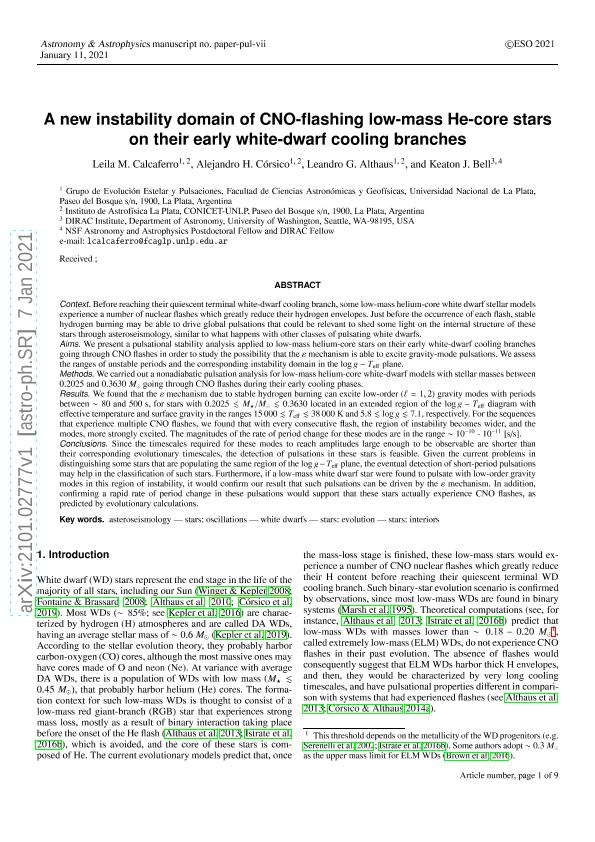Artículo
A new instability domain of CNO-flashing low-mass He-core stars on their early white-dwarf cooling branches
Fecha de publicación:
03/2021
Editorial:
EDP Sciences
Revista:
Astronomy and Astrophysics
ISSN:
0004-6361
Idioma:
Inglés
Tipo de recurso:
Artículo publicado
Clasificación temática:
Resumen
Before reaching their quiescent terminal white-dwarf cooling branch, some low-mass helium-core white dwarf stellar models experience a number of nuclear flashes which greatly reduce their hydrogen envelopes. Just before the occurrence of each flash, stable hydrogen burning may be able to drive global pulsations that could be relevant in shedding some light on the internal structure of these stars through asteroseismology, similarly to what occurs with other classes of pulsating white dwarfs. Aims: We present a pulsational stability analysis applied to low-mass helium-core stars on their early white-dwarf cooling branches going through CNO flashes in order to study the possibility that the ε mechanism is able to excite gravity-mode pulsations. We assess the ranges of unstable periods and the corresponding instability domain in the log g ‒ Teff plane. Methods: We carried out a nonadiabatic pulsation analysis for low-mass helium-core white-dwarf models with stellar masses between 0.2025 and 0.3630 M⊙ going through CNO flashes during their early cooling phases. Results: We found that the ε mechanism due to stable hydrogen burning can excite low-order (ℓ = 1, 2) gravity modes with periods between ∼80 and 500 s for stars with 0.2025 ≲ M⋆/M⊙ ≲ 0.3630 located in an extended region of the log g ‒ Teff diagram, with effective temperature and surface gravity in the ranges 15 000 ≲ Teff ≲ 38 000 K and 5.8 ≲ log g ≲ 7.1, respectively. For the sequences that experience multiple CNO flashes, we found that with every consecutive flash, the region of instability becomes wider and the modes are more strongly excited. The magnitudes of the rate of period change for these modes are in the range of ∼10‒10-10‒11 [s/s]. Conclusions: Since the timescales required for these modes to reach amplitudes large enough to be observable are shorter than their corresponding evolutionary timescales, the detection of pulsations in these stars is feasible. Given the current problems in distinguishing some stars that populate the same region of the log g ‒ Teff plane, the eventual detection of short-period pulsations may help in the classification of such stars. Furthermore, if a low-mass white dwarf star were found to pulsate with low-order gravity modes in this region of instability, it would confirm our result that such pulsations can be driven by the ε mechanism. In addition, confirming a rapid rate of period change in these pulsations would support the idea that these stars actually experience CNO flashes, as has been predicted by evolutionary calculations.
Archivos asociados
Licencia
Identificadores
Colecciones
Articulos(IALP)
Articulos de INST.DE ASTROFISICA LA PLATA
Articulos de INST.DE ASTROFISICA LA PLATA
Citación
Calcaferro, Leila Magdalena; Corsico, Alejandro Hugo; Althaus, Leandro Gabriel; Bell, Keaton J.; A new instability domain of CNO-flashing low-mass He-core stars on their early white-dwarf cooling branches; EDP Sciences; Astronomy and Astrophysics; 647; A140; 3-2021; 1-8
Compartir
Altmétricas




